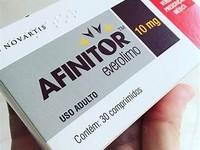Everolimus
CLINICAL USE
Prophylaxis of acute rejection in allogenic renal and cardiac transplants, in combination with ciclosporin and prednisolone
DOSE IN NORMAL RENAL FUNCTION
0.75 mg twice daily(Titrate according to levels – see ‘Other Information)
PHARMACOKINETICS
DOSE IN RENAL IMPAIRMENT
GFR (mL/MIN)
DOSE IN PATIENTS UNDERGOING RENAL REPLACEMENT THERAPIES
IMPORTANT DRUG INTERACTIONS
Potentially hazardous interactions with other drugs
ADMINISTRATION
Reconstition
–
Route
Oral
Rate of Administration
–
Comments
–
OTHER INFORMATION
None of the metabolites contributes significantly to the immunosuppressive activity of everolimusC max and AUC are reduced by 60% and 16% respectively when everolimus is taken with a high fat meal. Take doses consistently either with or without food to achieve consistent blood levelsPatients achieving whole-blood trough levels of ≥3.0 ng/mL have been found to have a lower incidence of biopsy-proven acute rejection
